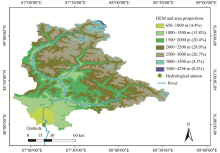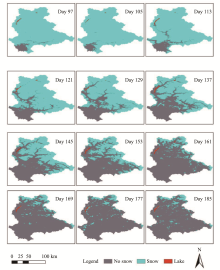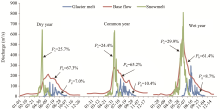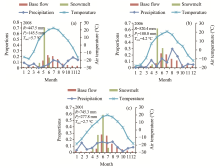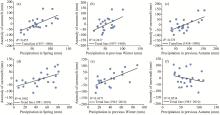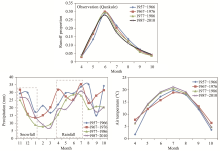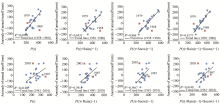Sciences in Cold and Arid Regions ›› 2020, Vol. 12 ›› Issue (3): 154–164.doi: 10.3724/SP.J.1226.2020.00154
Quantitatively estimate the components of natural runoff and identify the impacting factors in asnow-fed river basin of China
Jia Qin1( ),JinKui Wu1,2,TianDing Han2,QiuDong Zhao1,2
),JinKui Wu1,2,TianDing Han2,QiuDong Zhao1,2
- 1.Key Laboratory of Eco-hydrology Inland River Basin, Northwest Institute of Eco-Environment and Resources, Chinese Academy of Sciences, Lanzhou, Gansu 730000, China
2.State Key Laboratory of Cryospheric Sciences, Northwest Institute of Eco-Environment and Resources, Chinese Academy of Sciences, Lanzhou, Gansu 730000, China
| Aeschbacher J, Liniger H, Weingartner R, 2005. River water shortage in a highland lowland system: a case study of the impacts of water abstraction in the Mount Kenya region. Mountain Research and Development, 25: 155-162. | |
|
Arheimer B, Donnelly C, Lindström G, 2017. Regulation of snow-fed rivers affects flow regimes more than climate change. Nature Communications, 8(1): 62. DOI:1038/s41467-017-00092-8, 2017.
doi: 1038/s41467-017-00092-8 |
|
| Biswajit M, Asif K, 2014. A quantitative assessment of the genetic sources of the hydrologic flow regimes in Upper Indus Basin and its significance in a changing climate. Journal of Hydrology, 509: 549-572. | |
| Cao Z, Wang M, Proctor BA, et al., 2002. On the physical processes associated with the water budget and discharge of the Mackenzie basin during the 1994/95 water year. Atmosphere-Ocean, 40(2): 125-143. | |
| Chen F, Yuan YJ, Zhang TW, 2015. Long-term drought severity variations in the northern Altay Mountains and its linkages to the Irtysh River streamflow variability. Journal of Arid Land Resources and Environment, 29(8): 93-98. | |
| Chen R, Wang G, Yang Y, et al., 2018. Effects of cryospheric change on alpinehydrology: Combining a model with observations in the upper reaches of the Hei River, China. Journal of Geophysical Research, 123: 3414-3442. | |
| Ding Y, Zhang S, Chen R, 2017. Introduction to Hydrology in Cold Regions. Beijing: Science Press(in Chinese). | |
| Douville H, Royer JF, 1996. Influence of the temperate and boreal forests on the Northern Hemisphere climate in the Météo-France climate model. Climate Dynamics, 13(1): 57-74. | |
| Ghanbarpour M, 2007. Evaluation of spatial and temporal variability of snow cover in a large mountainous basin in Iran, Nord. Hydrology, 38: 45-58. | |
| Godsey SE, Kirchner JW, Tague CL, 2013. Effects of changes in winter snowpacks on summer low flows: case studies in the Sierra Nevada, California, USA. Hydrological Process, 28: 5048-5064. | |
| Helbig M, Boike J, Langer M, et al., 2013. Spatial and seasonal variability of polygonal tundra water balance: Lena River Delta, northern Siberia (Russia). Hydrogeology Journal, 21(1): 133-147. | |
| Jarvis A, Reuter HI, Nelson A, et al., 2008. Hole-Filled Seamless SRTM Data V4: International Centre for Tropical Agriculture (CIAT). http://srtm.csi.cgiar.Org/, accessed, 31. | |
| Kure S, Jang S, Ohara N, et al., 2013. Hydrologic impact of regional climate change for the snowfed and glacierfed river basins in the Republic of Tajikistan: hydrological response of flow to climate change. Hydrological Processes, 27(26): 4057-4070. | |
| Li X, Cheng G, Jin H, et al., 2008. Cryospheric Change in China. Global and Planetary Change, 62(3-4): 210-218. | |
| Liang X, 1994. A two-layer variable infiltration capacity land surface representation for general circulation models. Water Resources Series, Tech. Report no. 140, Department of Civil Engineering, University of Washington. | |
| Lohmann D, Raschke E, Nijssen B, et al., 1998. Regional scale hydrology: I. Formulation of the VIC-2L model coupled to a routing model. Hydrological Sciences Journal, 43(1): 131-141. | |
| Molini A, Katul GG, Porporato A, 2011. Maximum discharge from snowmelt in a changing climate. Geophysical Research Letter, 38: L05402. | |
| Mukhopadhyay B, 2013. Signature and hydrologic consequences of climate change within the upper-middle Brahmaputra Basin. Hydrological Processes, 27(15): 2126-2143. | |
| Nolin AW, Daly C, 2006. Mapping "at risk" snow in the Pacific Northwest. Journal of Hydrometeorology, 7(5): 1164-1171. | |
|
Nuerlan H, Shen YP, Mahat M, 2014. Impacts of climate change on hydrological processes in the ulungur river watershed, Altay mountains. Journal of Glaciology Geocryology, 36(3): 699-705. DOI: 10.7522/j.issn.1000-0240.2014.0084.
doi: 10.7522/j.issn.1000-0240.2014.0084 |
|
| Qin J, Ding Y, Wu J, et al., 2013. Understanding the impact of mountain landscapes on water balance in the upper Heihe River watershed in northwestern China. Journal of Arid Land, 5(3): 366-383. | |
|
Qin J, Ding Y, Han T, et al., 2017. Identification of the factors influencing the baseflow in the permafrost region of the north-eastern Qinghai-Tibet Plateau. Water, 9(9): 666-678. DOI: 10.3390/w9090666.
doi: 10.3390/w9090666 |
|
|
Qin J, Ding Y, Han T, 2020. Quantitative assessment of winter baseflow variations and their causes in Eurasia over the past 100 years. Cold Regions Science and Technology. DOI: 10.1016/j.coldregions.2020.102989.
doi: 10.1016/j.coldregions.2020.102989 |
|
| Ran YH, Li X, Lu L, 2010. Evaluation of four remote sensing based land cover products over China. International Journal of Remote Sensing, 31: 391-401. | |
| Räisänen J, Eklund J, 2012. 21st century changes in snow climate in Northern Europe: a high-resolution view from ENSEMBLES regional climate models. Climate Dynamics, 38(11-12): 2575-2591. | |
| Sharma V, Mishra VD, Joshi PK, 2013. Implications of climate change on streamflow of a snow-fed river system of the Northwest Himalaya. Journal of Mountain Science, 10(4): 574-587. | |
| Shen YP, Wang GY, Su HC, et al., 2007. Hydrological processes responding to climate warming in the upper reaches of kelan river basin with snow-dominated of the altay mountains region, Xinjiang, China. Journal of Glaciology and Geocryology, 29: 845-854. | |
| Smith-Adao LB, Nel JL, Le Maitre D, et al., 2011. A spatial assessment of riverine ecosystems and water supply in a semi-arid environment. River Research and Applications, 27(10): 1298-1314. | |
| Spence C, 2006. Hydrological processes and streamflow in a lake dominated watercourse. Hydrological Processes, 20(17): 3665-3681. | |
| Wang JZ, Liu ZH, Tashpolat T, et al., 2017. Variation of the baseflow and its causes of Hutubi River. Journal of Desert Research, 37(04): 793-801. | |
| Wang R, Yao Z, Liu Z, et al., 2015. Snow cover variability and snowmelt in a high-altitude ungauged catchment. Hydrological Processes, 29(17): 3665-3676. | |
| Wang S, Yan Y, Yan M, et al., 2012. Quantitative estimation of the impact of precipitation and human activities on runoff change of the Huangfuchuan River Basin. Journal of Geographical Sciences, 22(5): 906-918. | |
| Woo MK, Guan XJ, 2006. Hydrological connectivity and seasonal storage change of tundra ponds in a polar oasis environment, Canadian High Arctic. Permafrost and Periglacial Processes, 17(4): 309-323. | |
|
Yang D, Robinson D, Zhao Y, et al., 2003. Streamflow response to seasonal snow cover extent changes in large Siberian water-sheds. Journal of Geophysical Research: Atmospheres, 108(D18):4578. DOI: 10.1029/2002JD003149.
doi: 10.1029/2002JD003149 |
|
| Yang Z, 1991. Glacier Water Resources in China, Lanzhou: Gansu Science and Technology Press, pp. 119-120. | |
| Zhang WN, Liu ZH, Wang RJ, et al., 2015. Application of digital filtering theory in baseflow separation of Juntanghu River watershed in northern slope of the Tianshan Mountains. Arid Zone Research, 32(01): 35-39. | |
| Zhang Z, Deng S, Zhao Q, et al., 2019. Projected glacier meltwater and river run‐off changes in the Upper Reach of the Shule River Basin, north‐eastern edge of the Tibetan Plateau. Hydrological Processes, 33(7): 1059-1074. | |
| Zhao Q, Ding Y, Wang J, et al., 2019. Projecting climate change impacts on hydrological processes on the Tibetan Plateau with model calibration against the glacier inventory data and observed streamflow. Journal of Hydrology, 573: 60-81. |
| No related articles found! |
|
||

